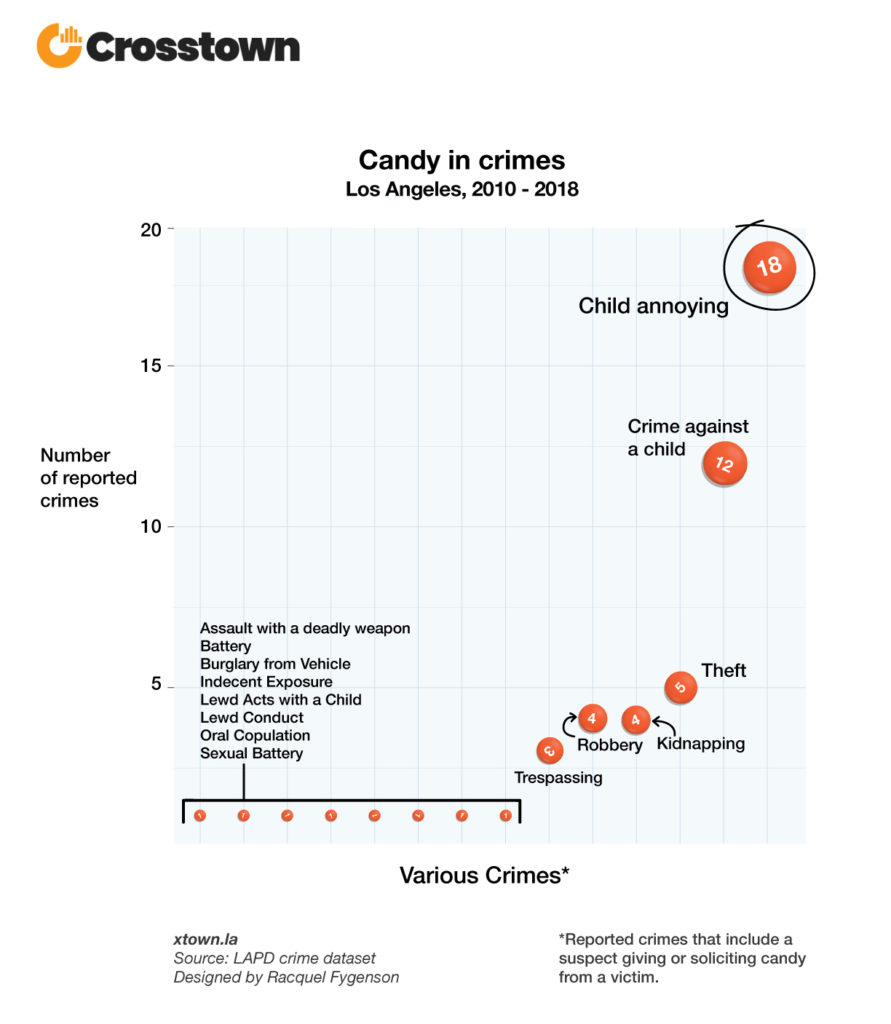Candy from strangers? The LAPD is watching
While “don’t accept candy from strangers” is a warning many of us heard growing up, how true is that really?
In order to find out, we analyzed crimes reported to the Los Angeles Police Department where a suspect offered or solicited candy from a victim. There is actually a code in the LAPD data that designates when candy is involved in a crime.
While rare, there were 54 cases in LA from 2010* to 2018, many of them involving children.
The number might seem marginal in comparison to overall crime in Los Angeles, but the actual crimes are not.

This piece is the first installment in a new Crosstown weekly feature, where we look at crimes that don’t always get attention because the reported numbers are relatively low. They may be uncommon, they may have fallen under the radar, they may even seem a little weird. But they’re important and interesting and we’re here to cover them. For this first installment, we’re returning to the childhood adage of not taking candy from strangers.
From 2010 to 2018, the most common crime that involved candy was “child annoying,” which accounted for 33% of all candy-related crimes.
Under California law, “annoy” and molest” mean the same thing. These crimes occur when a person is “motivated by an unnatural or abnormal sexual interest in children, engages in conduct with an adult whom he or she believes to be a child under 18 years of age.”
A suspect does not need to touch a child to be charged with annoying or molesting. Words alone may constitute annoying or molesting a child, such as the case in Los Angeles when a man was caught masturbating in a school parking lot while making eye contact with a minor.
The second most common candy-related crime over the past nine years were “crimes against children,” which include “physical and emotional abuse; neglect; and exploitation, such as through child pornography or sex trafficking of minors.” These crimes accounted for 22% of all crimes where candy was offered or solicited.
The crime of theft was associated with 9% of all candy-related crimes, while robbery – which involves taking something from someone by force or threat – was associated with 7.5% of all candy-related crimes.
Kidnapping tied for fourth place with robbery, accounting for 7.5% of candy-related crimes from 2010 – 2018.
Other crimes where candy was offered or solicited over the past nine years included trespassing, assault, vehicle burglary and lewd conduct.
Overall, it looks like your parents were right: sugar is indeed bad for you.
How we did it: We examined publicly available LAPD data on reports of crimes where a suspect offered or solicited candy from a victim from Jan. 1, 2010 (*the earliest available data) – Dec. 31, 2018. For neighborhood boundaries, we rely on the borders defined by the Los Angeles Times. Learn more about our data here.
LAPD data only reflects crimes that are reported to the department, not how many crimes actually occurred. In making our calculations, we rely on the data the LAPD makes publicly available. LAPD may update past crime reports with new information, or recategorize past reports. Those revised reports do not always automatically become part of the public database.
Want to know how your neighborhood fares? Or simply just interested in our data? Email us at askus@xtown.la.






